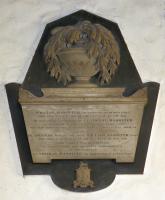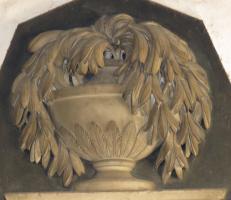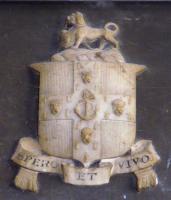Hornchurch St Andrew, London/Essex - Monuments

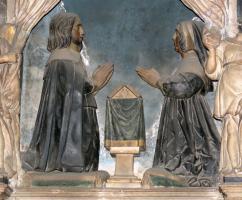
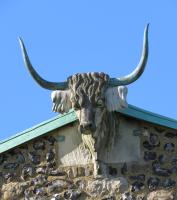
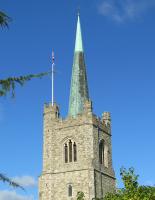
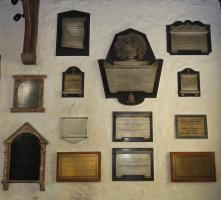
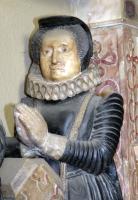
St Andrew's Church, Hornchurch, has a distinctive appearance because of its tall copper-green spire rising the three stage tower
of the 15th Century, which has a newel turret. For the rest, it is a goodly size, 13th Century with later additions
and a Victorian restoration, stone clad, with aisles and a projecting low chancel. It is at the back of that that we can see
the well-known bull's head with its broad horns, quite small compared to the gable of the chancel, but being at the top,
giving something of a silhouette against the sky if the viewer chances to pass look from the right spot (if you are interested in sculpture of bulls,
see this page).
The horns are of some copper alloy, the head carved in stone, rather shaggy (see picture above, click to enlarge), and apparently dating from no later than the beginning
of the 19th Century, there previously being a pair of bull's horns affixed with lead. Weever, in his book Funerary Monuments of 1631,
writes that
'The inhabitants of this parish say (by tradition) that this church was built by a female convert,
to expiate any satisfaction for her former sins; and that it was called Hore-church at the first, until by a certain king,
but by what king they are uncertain, who came riding that way, it was called the Horned-church, who caused those horns
to be put out at the east end of the same, in rememberance of so remarkable a foundation.'
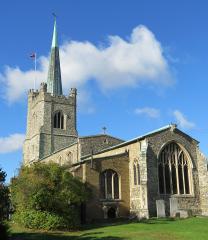
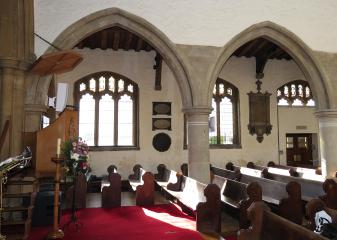
St Andrew's Church, Hornchurch, exterior and an interior view.
Inside, the Church feels quite tall, on account of the clerestory and the high roof, 15th Century, with broad arches to
the well-lit aisles. The monuments we have come to see are on the aisle walls, including a large cluster near the door.
Monuments
Early monuments, 16th-18th Centuries
- William Ayloffe [Ayliff] of Bretons, d.1517, is believed to be the person commemorated by a grand altar tomb,
with three panels on each side and one at the end (the other end is against a wall), each panel being carved with a quatrefoil
with a shield of arms in the centre. On top is a polished dark slab, and underneath is a paler base stone in three receding steps.
It is the coats of arms which identify Ayloffe, and his wife Audrey Shaa, and at one time the rector of Stanstead Rivers,
Revd. Joseph Ayloffe, owned a brass to William Ayloffe which is thought to have belonged to this monument.
Weever's Funerary Monuments, a reliable 17th Century text, refers to an inscription to him in Hornchurch thus:
[A gravestone] 'which I find thus inscribed... Of yowr cheritie a Pater noster and an Ave [Maria] for the sowl of William Ayliff gentleman,
owner of the mannowr of Bret-howse who died 1517.'
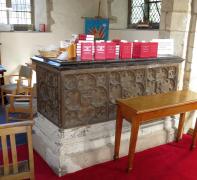 William Ayloffe, d.1517, altar tomb.
William Ayloffe, d.1517, altar tomb.
- Carolus [Charles] Rynius Blandford, d.1610. The inscription on a black panel, arched at the top,
within a surround of carved alabaster with upper and lower shelf. The relief carving includes ribbons, strings, tassels and
projecting flowers, and flattened portions which likely once contained attached decorations now lost.
This sort of low relief carving, and the use of the fine red and white alabaster, is most characteristic of the period;
and we can see that there was originally more to the monument at the sides and top – and maybe a lot more, as we shall see below
with the Thomas Withrings monument.
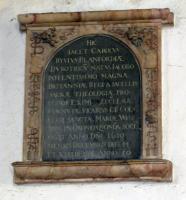
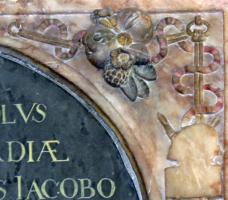
Carolus Blandford, d.1610, alabaster.
- Francis Rame, d.1617, and his wife Helen Rame, d.1613. A good kneeler monument, with the husband and wife
in civilian costume, facing each other across their prayer desk, kneeling on red tasselled cushions, as is normal.
They are under a low canopy held up by square side pilasters decorated with ribbons carved in low relief around central shafts,
with on the one side a skull, the other an hourglass as memento mori. Underneath are their ranked offspring, ten in all,
the nine sons at the front, with the sole daughter at the very back. It is unusual to have them all faced the same way,
but the imbalance in numbers made it compositionally difficult to do otherwise. The son at the front, the heir, has the biggest cloak,
but oddly, the one behind him has no cloak, unlike all the rest. To the sides of this panel are thick supporting blocks with cabuchons,
and the inscription is on a panel beneath. At the top rest two skulls, and there may have once been a coat of arms in the middle.
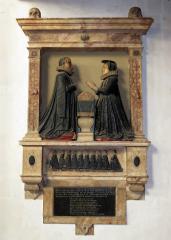
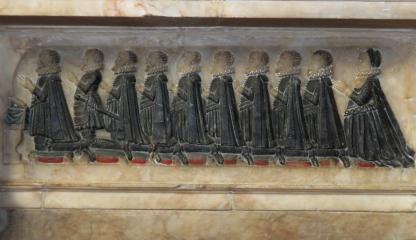
Francis and Helen Rame, 1610s, and multitudinous offspring, kneeler monument.
- Caroli [Charles] Pratt, d.1622, with a Latin inscription, erected by his wife Elizabeth and son Michael.
Again with a central arched black panel, here with pillars of red and white marble to the sides, and a triangular 'roof' on top,
with low relief carving and some small central appendage which suggests a shield of arms was once affixed in front of it –
the faint shield shape has indentations which would have been to give a good grip to the cement, though not good enough to last
a full 400 years. At the base, a thin shelf, and nice projecting side brackets with finely carved little pendant pineapples;
whatever panelling was once in between these has also been lost.
- Apparently there is another monument with a single kneeler, Humphrey Pye, d.1625, but I did not see it.
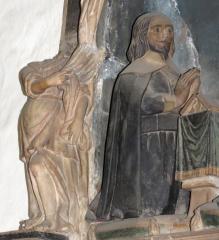
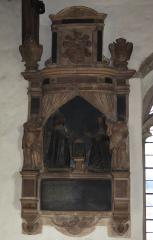
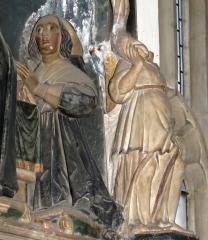
Richard Blakstone, d.1638, and his wife.
- Richard Blakstone, [Blackstone] d.1638, with a poem, including such immortal lines as 'His righteous Soule
was a Relligious Shrine // Of Virtues Moral and Divine'. Another kneeler monument, thus with the figures of Richard Blakstone
and his wife carved as kneeling, facing each other, hands raised in prayer, a draped prayer book stand between them.
They are under a canopy, from which descends a curtain held open by a pair of standing female figures, both having lost their heads,
and on the basis of the one behind the wife, they were originally winged angels. The two mortals wear gowns, only their
broad collars revealing they were wealthy people; he has shoulder length hair and a trimmed beard; she, a hood. At the top,
a shield of arms within a frame with its own curved pediment within which lurks a small winged cherub head; there are cartouches
with more painted shields of arms to the sides. The inscription, on a black panel, is below Richard Blakstone's statue,
while that under his anonymous wife is blank. At the base, supporting brackets to left and right are terminated with carved flowers,
and the central apron has a relief carving of a winged cherub head, much damaged. More examples of kneeler monuments are on this page.
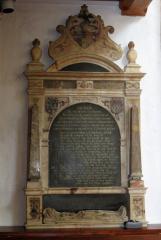
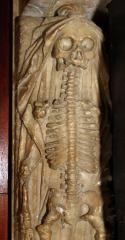
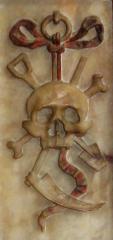
Thomas Withrings, d.1651, Chief Postmaster, monument, skeleton, and relief carving.
- Thomas Withrings, d.1651, with a eulogy beginning that he was 'Cheife Postmaster of Great Brittaine & Forreigne parts,
second to none for unfathom'd pollicy, unparralleld sagacious & diving genious, witness his great correspondency in all parts
of ye Christian world' and carrying on in the same upbeat vein. Grand alabaster panel with a recumbent skeleton at the base.
The inscription is on an arched black panel, as for Carolus Blandford noted above, and the viewer is immediately struck by
how the Blandford piece looks like the centre portion of the Withrings one. It may be then, that the Blandford monument is
simply the surviving piece of some original monument much like the later Withrings one – and indeed the Withrings monument
may have been ordered along the same lines as the earlier one. Back to the complete monument we do have, the Withrings one
has a surround with painted shields of arms and ribbons, tall obelisks of a rich purple streaky marble in front of pilasters
to the sides, and the familiar entablature above, decorated with low relief carving including a central winged cherub head.
On top is a low, curved pediment supporting a carved, painted shield of arms made more massive by additional side S-curls -
this over-sizing of the summit coat of arms
is not unusual among monuments of this date. To the sides are two small flaming urns. The base has projecting plinths
to support the obelisks at the sides, with a flaming pot hung upside down on the one side, the extinction of the flame
representing the extinction of life, and on the other side, a skull crossed with a single bone, a gravedigger's spade,
and a scythe (cutting down of life). And in the centre we have the little skeleton, lying on its back in a shroud tied
above the forehead, and anatomically rather good, excepting the visible hand is on the large side. An exceptional piece
with irresistible allegory.
- Franciscus Pruiean [Francis Prugean or Prujean], d.1666, a medical man, with a long Latin inscription, in small text
on a black panel. The stone frame has two attached Ionic pillars supporting an entablature and a heavy pediment. This is of the type
termed 'swan-necked', thus with the slanting sides being curled up at the tops to leave an opening (i.e. a broken, curved pediment),
and within this, the shield of arms surrounded by much mantling. The lower part of the monument contains a shelf supported on curved,
fluted brackets, with a central empty panel, and stone termini. Characteristic of the period, and with the carving on a suitable scale
for the monument.
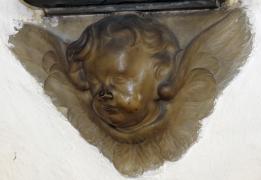
- Alice Aylet, d.1731. A good example of a panel of this period, with thick pilasters and entablature of
a variegated marble with many shattered inclusions; at the top, a shelf, central tall pot or funereal urn, and bases of
some missing elements to the sides. Below the inscription, a narrow shelf, then an apron carved with a cartouche,
once painted with the coat of arms, crossed branches, and black bricklike supports to the sides, with outer scrolling
and bell-shaped termini; at the very base of the centre under a short shelf is a pug-nosed winged cherub head (picture above).
- Richard Spencer, d.1784, and his wife Maria Elizabeth Spencer, d.1772, erected by Henry and Dorothy Askew.
A figure piece by the important sculptor John Flaxman. He was a great champion of the purest Classical designs,
incorporating graceful young female figures as here. The inscription is on the plinth of a roundel bearing a double portrait
of Richard and Maria Spencer, he seen in three quarters view, she a low relief profile. They are both rather plump,
with much flesh about the chin, but he is given dignity with a powerful forehead and waving and curling locks of hair.
Beneath, to either side of the plinth, stand two angels, lithe and feminine, but with the coolness and distance of Hellenic Classicism.
Flaxman was a master sculptor, as we can see from the beautiful drapery, which emphasises and enhances the shapely legs of the pair.
The arms too are nicely modelled, with the muscles associated with ancient Greek maidens. At the base, beneath the supporting shelf
(which Flaxman signs on the side) is a shield of arms carved in low relief, and including three heraldic rabbit heads, often a symbol
of the Trinity; the crossed branches around this are most beautifully carved pine needles.
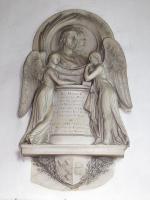
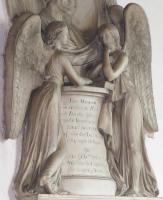
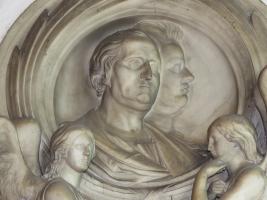
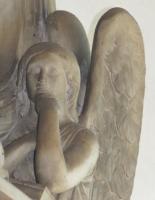
John Flaxman's monument to Richard and Elizabeth Spencer, 1784.
19th Century panels
The collection of 19th Century panels includes one white one and 10 characteristic white-on-black ones,
which include two of the most common shapes, firstly looking like the end of a tomb chest, thus a rectangle with upper shelf or lid
and two small feet, and secondly looking like the end of a casket, which is similar but with outward slanting sides.
One has a well-carved wilting pot plant, and another is carved in the form of a hanging scroll. Five of them bear visible signatures
of the masons who made them, always interesting to see.
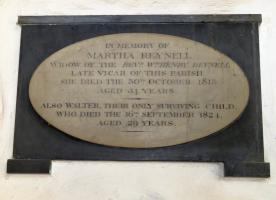

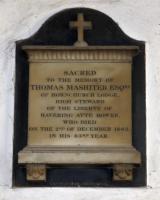
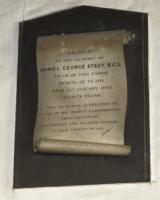
Variety in white-on-black panels: Reynell, Walker, Thos. Mashiter, and Revd. Stacy.
Monuments from the 20th Century
There is one more stone panel, one iron or blackened brass roundel, and several plainish modern brass panels, mostly to soldiers
those who fell in World War I:
- Charles Henry Baker, d.1915, who died from wounds received in the Battle of Gallipoli. Round metal panel with
a thick border of oak leaves and acorns, symbols of enduring strength.
- Benjamin Harding Newman, d.1917, and his wife Charlotte Augusta Newman, d.1908, erected by their son.
Plain panel in cream alabaster with a serpentine border, favoured colours for the Arts and Crafts period.
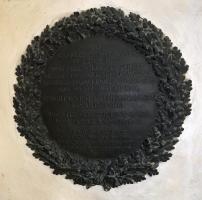
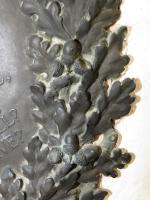
Charles Baker, d.1915, and detail of acorns.
Modern brasses:
Also in the Church:
Outside, the Church stands in its graveyard, entered by a good lych gate, with several low-hanging trees giving atmosphere.
The usual crop of tombstones, but including a few with raised crosses of the type known as raised ledgers
(see this page and this page) surrounded by iron railings,
and a few with sculptural adornment, e.g. skull and crossbones (lots more such things on this page),
and a Churchyard Cross war memorial raised on steps.
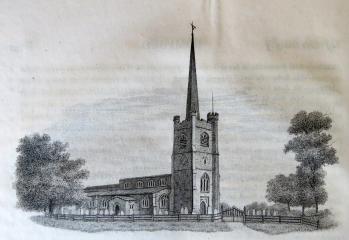
Hornchurch, early 19th Century view.
With many thanks to the Church authorities for kind permission to use pictures from inside St Andrew's Hornchurch;
see the Church website at https://www.parishofhornchurch.co.uk/st-andrews-church.html.
Top of page
Essex-in-London church monuments
Dagenham Parish Church to west // Leyton Parish Church (further westward) // or west and north to Walthamstow Church // Monuments in some other London churches
Introduction to church monuments // Angel statues // Cherub sculpture
Home
Visits to this page from 14 Jan. 2018: 8,588

















